WEEKLY HIGHLIGHTS FOR 11 JUNE 2004:
GRAVITY PROBE B MISSION UPDATE
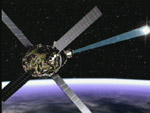
On its 52nd day in orbit, the spacecraft continues to be in good health, with all subsystems performing very well. The spacecraft’s orbit, which will remain in full sunlight through August, is stable and meets our requirements for transition into the science phase of the mission. All four gyros are digitally suspended and have passed several very slow-speed calibration tests. Furthermore, the science telescope is locked onto the guide star, IM Pegasi, and we have verified that it is locked onto the correct star
- Over the past two weeks, through a combination of software modifications,
revised procedures, and commands sent directly to the spacecraft, considerable
progress has been made in adjusting the Attitude and Translation Control
system (ATC) to properly maintain the spacecraft’s attitude (pitch,
yaw, and roll) in orbit. The ATC system accomplishes this important job by
controlling the flow of helium gas, continually venting from the Dewar, through
the spacecraft’s micro thrusters. This system is critical to the success
of the mission because it maintains the required roll rate of the spacecraft,
it keeps the spacecraft and science telescope pointed at the guide star,
and it keeps the spacecraft in a drag-free orbit. Thus, the team is particularly
gratified to now have the ATC functioning reliably, with the science telescope
locked onto IM Pegasi.
- The “Pegasi” part of the guide star’s name indicates
that is located in the constellation Pegasus; the “IM” prefix
(as opposed to a Greek letter prefix) indicates that it is a variable star;
in fact, it is actually part of a binary star system (one of a pair of stars
that closely orbit each other). On a star map, its location coordinates are:
- Right Ascension--22 hours 53 minutes 2.3 seconds
- Declination--16 degrees 50 minutes 28.3 seconds
IM Peg is about 300 light years from Earth, and its maximum magnitude is 5.85--barely visible to the naked eye. In the Northern Hemisphere, you can view the constellation Pegasus in the evening sky from late August (rises on the Eastern horizon) to early January (sets on the Western horizon).
- The process of locking the science telescope onto IM Pegasi started with
star trackers on either side of the spacecraft locating familiar patterns
of stars. Feedback from the star trackers was used to adjust the spacecraft’s
attitude so that it was pointing to within a few degrees of the guide star.
The telescope’s shutter was then opened, and a series of increasingly
accurate “dwell scans” was performed to home in on the star.
Since the spacecraft is rotating along the axis of the telescope, imbalance
in the rotation axis can cause the guide star to move in and out of the telescope’s
field of view. Feedback from the telescope was sent to the ATC system, which
adjusted the spacecraft’s attitude until the guide star remained focused
in the telescope throughout multiple spacecraft roll cycles. The ATC was
then commanded to “lock” onto the guide star.
- Finally, to verify that the telescope was locked onto the correct guide star, the micro thrusters were used to point the spacecraft/telescope at a known neighboring star, HD 216635 (SAO 108242), 1.0047 degrees above IM Pegasi. When the telescope was pointed at this location, the neighboring star appeared with anticipated brightness, and there were no other stars in the immediate vicinity. Thus, the sighting of the star, HD 216635, confirmed the correct relationship between the locations of the two stars, ensuring that the telescope is indeed locked onto the correct guide star. In addition, the telescope has also seen the star HR Peg (HR 8714), a brighter and redder star, located less than half a degree to the left of IM Pegasi.
- This past week the team continued performing calibration tests of all gyros, spinning at less than 1 Hz (60 rpm). In addition, the team successfully tested a back-up drag-free mode of the spacecraft with three of the gyros for an entire orbit, and, more significantly, the team completed its first successful test of the primary drag-free mode since re-configuring the micro thrusters, using gyro #3.
- In primary drag-free mode, the Gyro Suspension System (GSS) is turned off on one of the gyros, so that no forces are applied to it. The ATC uses feedback from the position of this gyro in its housing to “steer” the spacecraft, keeping the gyro centered. Back-up drag-free mode is similar, but in this case the GSS applies very light forces on the gyro to keep it suspended and centered in its housing. The ATC uses feedback from the GSS to “steer” the spacecraft so that the GSS forces are nullified or canceled, thereby keeping the gyro centered. Applying forces with the GSS to suspend the drag-free gyro adds a very small, but acceptable, amount of noise to the gyro signal, and thus, either primary or back-up drag-free mode can be employed during the science experiment. Upcoming milestones include maintaining the spacecraft in a drag-free orbit, and beginning gyro calibration tests at spin rates of up to 5 Hz (300 rpm).
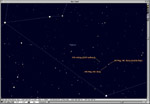
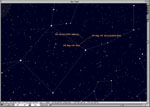
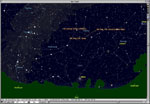
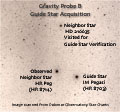
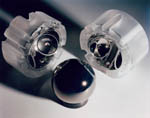
The spacecraft is being controlled from the Gravity Probe B Mission Operations Center, located here at Stanford University. The Stanford-NASA/MSFC-Lockheed Martin operations team is continuing to perform superbly.
Please Note: During the Initialization & Orbit Checkout (IOC) Phase of the GP-B mission, we will update this Web site and send out an email update once a week (usually on Thursday or Friday) to keep you apprised of our progress. From time to time, we may post and email extra updates, as warranted by mission events.
Images & Photo: The drawing of the GP-B spacecraft in orbit, was extracted from an animation created by Adam Jeziak and Aaron Pozzer. This animation is part of a 26-minute movie about GP-B, entitled Testing Einstein's Universe (see description below). The three sky chart images, showing the guide star, IM Pegasi and its neighbors in the constellation Pegasus, were generated by the Voyager III Sky Simulator from Carina Software. The photo of the star field containing IM Pegasi and its neighbors was scanned from a Palomar Observatory Sky Chart. Finally, the photo of the GP-B gyroscope rotor (sphere) and housings was taken by photographer Don Harlan. Click on the thumbnails to view enlarged copies of these images.
LEARN MORE ABOUT THE GP-B GUIDE STAR, IM PEGASI
For an overview about why we chose IM Pegasi as our guide star, and its importance to the GP-B mission, see our Guide Star FAQ. Also, pages 18-20 of the Gravity Probe B Launch Companion contain information about the guide star and the science telescope.
Furthermore, the ETH Institute of Astronomy in Zurich, Switzerland, is working with the Harvard-Smithsonian Center for Astrophysics to provide detailed optical information about the GP-B guide star, IM Pegasi. You can find out about the ETH Institute's work in monitoring magnetic activity on IM Pegasi and the Doppler Imaging Technique used for this purpose on the ETH Institute of Astronomy GP-B Web page.
TRACKING THE GP-B SPACECRAFT
Find the Gravity Probe B satellite in the sky at NASA's satellite tracking web site. See where GP-B is with respect to the terminator (the day-night boundary on the Earth's surface), or just enter your zip code to see if GP-B might be over your neighborhood. The best time to look for it is usually at dusk.
Also, you can track the GP-B spacecraft on your Palm OS or Pocket PC Personal Digital Assistant (PDA), using either PocketSat or PocketSat+ from Big Fat Tail Productions. Both products are PDA Shareware, so you can try them out for free. If you decide to use them, Big Fat Tail asks that you pay a nominal shareware fee.
FOLLOW IOC ACTIVITIES AND LEARN MORE ABOUT GRAVITY PROBE B
If you are interested in following the IOC procedures more closely, you'll find a schedule and description of them on pages 12-14 of the Gravity Probe B Launch Companion. This document also provides an overview and explanation of the Gravity Probe B experiment and information about the spacecraft and GP-B's amazing technologies. Click here to download the GP-B Launch Companion in Adobe Acrobat PDF format. (Please note: this file is 1.6 MB, so it may take awhile to download if you have a slow Internet connection.)
Norbert Bartel, Professor of Astrophysics and Space Sciences at York University in Toronto, Canada, has produced and directed a 26-minute documentary movie about the Gravity Probe B experiment entitled, Testing Einstein's Universe. This movie, along with 80 minutes of additional video about relativity, physics, and astronomy is available on a DVD, which you can purchase from the Website: http://www.astronomyfilms.com/
VIEW A VIDEO OF THE GP-B LAUNCH
 Click
here to view a 3 1/2 minute QuickTime video clip of the GP-B launch, produced
by the Stanford News Service. Please note that the video requires Quick Time to play.
Click here to
link to
download Quick Time.
Click
here to view a 3 1/2 minute QuickTime video clip of the GP-B launch, produced
by the Stanford News Service. Please note that the video requires Quick Time to play.
Click here to
link to
download Quick Time.![]()
FOLLOWING THE GP-B MISSION ON THE WEB
In addition to this Web site, here are some other Web sites that have information, photos, and video of the GP-B launch and mission.
- The ELV Missions Virtual Launch Center Web page on the John F. Kennedy Space Center Web site has information and several streaming video clips covering the GP-B mission. (You can view these video clips free of charge, but you will need to have either the Real Media Player or Windows Media Player installed on your computer to view them.)
- NASA's Marshall Space Flight Center Gravity Probe B.com Web page has a number of great photos from the GP-B launch, including photos of the spacecraft separation, as well as other information about Gravity Probe B.
- The Science @ NASA Web site, hosted by NASA's Marshall Space Flight Center, posts several stories each month about scientific research projects in which NASA is involved. This site currently features two general interest stories about Gravity Probe B: In search of Gravitomagnetism and A Pocket of Near Perfection. (In addition to the Web versions, these stories are also available in both plain text and streaming audio formats.)
- Photographer William G. Hartenstein's Web site has an extraordinary set of photos that he took on launch day.
- Another very comprehensive source of information about the GP-B launch is the Spaceflight Now Web site. This site contains an excellent photo gallery, as well as a number of Quicktime video clips of the launch. However, you have to become a subscriber to this site ($$$) in order to view the video clips.
GRAVITY PROBE B IN THE NEWS
Sunday evening, April 18th, a feature story about Gravity Probe B and principal investigator, Francis Everitt, aired on ABC World News Tonight. Click here to read a text version of the ABC News story. Also on April 18th, NPR's David Kestenbaum talked with GP-B's principal investigator, Francis Everitt on the program All Things Considered. On Friday, April 16th, Gravity Probe B Co-Principal Investigator, John Turneaure, was interviewed by Ira Flatow on NPR Talk of the Nation—Science Friday.
On Tuesday, April 13,2004, Gravity Probe B was the lead story in the Science section of the New York Times, and it was one of the front page stories in the San Jose Mercury News. (You'll need to register on the Web sites of these newspapers to view these stories online.) In addition, a story about GP-B appeared on the New Scientist Web on April 13, 2004.
The official pre-launch Gravity Probe B mission and science briefing was held on Friday, April 2, 2004 at 1:00 PM Eastern Daylight Time at NASA Headquarters in Washington, D.C. The participants in the briefing (pictured from left to right in the photo) were:

- Anne Kinney, Director of Astronomy/Physics Division, NASA Headquarters
- Rex Geveden, Program Manager, GP-B and Deputy Director, NASA's Marshall Space Flight Center in Huntsville, Alabama.
- Francis Everitt, GP-B Principal Investigator at Stanford University, Stanford, California
- Bradford Parkinson, GP-B Co-Principal Investigator at Stanford University, Stanford California
- Kip Thorne, Feynman Professor of Theoretical Physics, California Institute of Technology, Pasadena, California
You can view a Real Player streaming video of this briefing on the Kennedy Space Center GP-B Web site.
RECEIVE GRAVITY PROBE B WEEKLY HIGHLIGHTS BY EMAIL
If you are interested in automatically receiving these weekly highlights and other important GP-B mission information by email, you can subscribe to our Gravity Probe B Update email list by sending an email message to "majordomo@lists.Stanford.edu" with the command "subscribe gpb-update" in the body of the message (not in the Subject line). You can unsubscribe from this mailing list at any time by sending an email message to the same address with the command, "unsubscribe gpb-update" in the body of the message.
Previous Highlight
Index of Highlights


